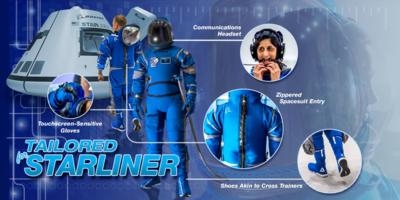Lighter, More Comfortable Suits Designed For The New Boeing Spacecraft
Astronauts heading into orbit aboard Boeing’s Starliner spacecraft will wear lighter and more comfortable spacesuits than earlier suits astronauts wore. The suit capitalizes on historical designs, meets NASA requirements for safety and functionality, and introduces cutting-edge innovations.

Boeing unveiled its spacesuit design Wednesday as the company continues to move toward flight tests of its Starliner spacecraft and launch systems that will fly astronauts to the International Space Station.
The new Starliner suit's material lets water vapor pass out of the suit, away from the astronaut, but keeps air inside. That makes the suit cooler without sacrificing safety. Materials in the elbows and knees give astronauts more movement, too, while strategically located zippers allow them to adapt the suit's shape when standing or seated.
A few of the advances in the design:
- Lighter and more flexible through use of advanced materials and new joint patterns
- Helmet and visor incorporated into the suit instead of detachable
- Touchscreen-sensitive gloves
- Vents that allow astronauts to be cooler, but can still pressurize the suit immediately
- The full suit, which includes an integrated shoe, weighs about 20 pounds with all its accessories – about 10 pounds lighter than the launch-and-entry suits worn by space shuttle astronauts.
"The most important part is that the suit will keep you alive," astronaut Eric Boe said. "It is a lot lighter, more form-fitting and it's simpler, which is always a good thing. Complicated systems have more ways they can break, so simple is better on something like this."
Of course, the suit has to be as functional as it is safe, Boe said. If an astronaut gets strapped in but can't reach the switches or work the touchscreen, the spacesuit would not be effective. That's why astronauts have spent some of their time sitting inside a Starliner mock-up wearing the spacesuit. They climb in and out repeatedly and try out different reaches and positions so they can establish the best ways for astronauts to work inside the spacecraft's confines.
"The spacesuit acts as the emergency backup to the spacecraft's redundant life support systems," said Richard Watson, subsystem manager for spacesuits for NASA's Commercial Crew Program. "If everything goes perfectly on a mission, then you don't need a spacesuit. It's like having a fire extinguisher close by in the cockpit. You need it to be effective if it is needed."

Boe and astronauts Bob Behnken, Doug Hurley and Suni Williams are training for flight tests using spacecraft under development for NASA's Commercial Crew Program, including Boeing's Starliner and SpaceX’s Crew Dragon systems. Flight tests with astronauts aboard are slated to begin in 2018.
The spacesuits astronauts wear for walking in space are already aboard the station. Heavier and bulkier than launch-and-entry suits, spacewalking ensembles – called EMUs for extravehicular mobility units – have to function as a spacecraft unto themselves.
Standing inside the company's Commercial Crew and Cargo Processing Facility at NASA’s Kennedy Space Center in Florida, former astronaut Chris Ferguson, who is now director of Crew and Mission Systems for Boeing, modeled the new suit in front of a mock-up of the Starliner spacecraft. On launch day, astronauts will don the suit in the historic Crew Quarters before striding across the Crew Access Arm at Space Launch Complex 41 and boarding a Starliner as it stands atop a United Launch Alliance Atlas V rocket.
"We slogged through some of the real engineering challenges and now we are getting to the point where those challenges are largely behind us and it's time to get on to the rubber meeting the road," Ferguson said.
Carrying up to four astronauts at a time for NASA, operational Commercial Crew missions are to take astronauts to the space station on a regular basis permitting the crew on the orbiting laboratory to grow to seven residents. That will mean more science and research time for NASA to seek vital answers for the challenges of future deep-space missions.
From this point, Boeing will continue fit checks and other testing alongside the astronauts as all the teams train for the missions and push toward flight tests.
"To me, it's a very tangible sign that we are really moving forward and we are a lot closer than we've been," Ferguson said. "The next time we pull all this together, it might be when astronauts are climbing into the actual spacecraft."
(Images provided with NASA news release)
 ANN's Daily Aero-Linx (04.16.24)
ANN's Daily Aero-Linx (04.16.24) Aero-News: Quote of the Day (04.16.24)
Aero-News: Quote of the Day (04.16.24) Airborne 04.10.24: SnF24!, A50 Heritage Reveal, HeliCycle!, Montaer MC-01
Airborne 04.10.24: SnF24!, A50 Heritage Reveal, HeliCycle!, Montaer MC-01 Airborne 04.12.24: SnF24!, G100UL Is Here, Holy Micro, Plane Tags
Airborne 04.12.24: SnF24!, G100UL Is Here, Holy Micro, Plane Tags Airborne-Flight Training 04.17.24: Feds Need Controllers, Spirit Delay, Redbird
Airborne-Flight Training 04.17.24: Feds Need Controllers, Spirit Delay, Redbird




